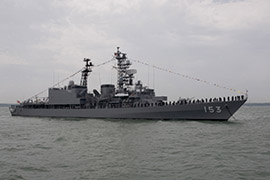Asagiri-class destroyer
Appearance
 JS Yūgiri anchored in the Solent
| |
| Class overview | |
|---|---|
| Builders | |
| Operators | JMSDF |
| Preceded by | Template:Sclass- |
| Succeeded by | Murasame-class destroyer |
| Built | 1986–1989 |
| In commission | 1986– |
| Completed | 8 |
| Active | 8 |
| General characteristics | |
| Displacement | 3,500 tons standard, 4,900 tons hull load |
| Length | 137 m (449 ft 6 in) |
| Beam | 14.6 m (47 ft 11 in) |
| Draft | 4.5 m (14 ft 9 in) |
| Depth | 8.8 m (28 ft 10 in) |
| Propulsion | 4 gas turbines 54,000 shaft horsepower |
| Speed | 30 knots (56 km/h) |
| Range | 8,030 nmi (14,870 km) at 14 kn (26 km/h) |
| Complement | 220 |
| Sensors and processing systems | |
| Electronic warfare & decoys |
|
| Armament |
|
| Aircraft carried | 1 × SH-60J(K) anti-submarine helicopter |
The Asagiri-class destroyer was built during the 1980s for service with the Japanese Maritime Self Defense Force.
This class of general purpose destroyer is an extended version of its predecessor Template:Sclass-s, and is mainly tasked with ASW and ASUW. The Asagiri-class vessels feature several enhancements and/or improvements over the Hatusyuki class, such as:
- COGAG Propulsion System.
- Compared with the COGOG propulsion system of the Hatsuyuki class, this class has the COGAG propulsion system with enhanced capacity. The COGAG propulsion system is composed of four Kawasaki-Rolls-Royce Spey SM1A gas turbines.[1]
- Advanced radar systems.
- This class is equipped with the OPS-28 surface search radar. The OPS-28 is analogous to the American Target Acquisition System Mk.23 with the Track while scan capability. Later ships of this class introduced the OPS-24 air search 3D radar. The OPS-24 is the first shipboard active electronically scanned array radar in the world.[2]
- Full-configuration destroyer CDS.
- The earlier batch was equipped the OYQ-6 combat direction system (CDS). This system employed one AN/UYK-20 computer as the same as OYQ-5 tactical data processing system of the Hatsuyuki class, but it can exchange tactical data via Link-11, which the OYQ-5 does not support. Later, all OYQ-6 systems were upgraded to the OYQ-7, integrated with OYQ-101 ASW Direction System.[3]
- All ships of this class were later retrofitted with the terminal for the MOF system, the key operational C4I system of the JMSDF which uses the Superbird SHF-SATCOM.[3]
- Enlarged aircraft facility.
- The hangar is enlarged in order to accommodate two helicopters, but generally only one helicopter is used operationally.[4]
Asagiri, Yūgiri, and Amagiri were named after World War II destroyers. Amagiri's World War II namesake rammed and sank PT-109.
The Yamagiri and Asagiri have been converted into training vessels.
Ships in the class
| Pennant no. | Name | Laid down | Launched | Commissioned | Builder | Home port | Note |
|---|---|---|---|---|---|---|---|
| DD-151 TV-3516 |
Asagiri | 19 September 1986 | 1988 | IHI Corporation, Tokyo | Kure | Converted to training vessel (TV-3516) on 16 February 2005 re-converted to DD-151 on March 2012 | |
| DD-152 TV-3515 |
Yamagiri | 10 October 1987 | 1989 | Mitsui, Tamano | Kure | Converted to training vessel (TV-3515) on 18 March 2004, re-converted to DD-152 on March 2011 | |
| DD-153 | Yūgiri | 21 September 1987 | 1989 | Sumitomo Heavy Industries Uraga Shipyard | Ominato | Involved in the June 3rd, 1996 accidental shootdown of a USN A-6E Intruder, during a life-fire CIWS exercise (part of RIMPAC '96). Aircrew ejected safely and were subsequently rescued by the Yūgiri. Though a malfunction in the Phalanx CIWS was initially implicated as the cause of the incident, human error was later blamed. | |
| DD-154 | Amagiri | 9 September 1987[5] | 28 February 1989[5] | IHI Corporation | Maizuru | ||
| DD-155 | Hamagiri | 4 June 1988 | 1990 | Hitachi, Maizuru | Ominato | ||
| DD-156 | Setogiri | 12 September 1988 | 1990 | Hitachi, Maizuru | Ominato | ||
| DD-157 | Sawagiri | 25 December 1988 | 1990 | Mitsubishi Heavy Industries Nagasaki Shipyard | Sasebo | ||
| DD-158 | Umigiri | 11 September 1989 | 1991 | IHI Corporation | Kure |
References
- ^ Yasuo Abe (June 2011). "2. Propulsion system (Hardware of JMSDF destroyers)". Ships of the World (in Japanese) (742). Kaijin-sha: 106–111.
- ^ Tomohiko Tada (March 2010). "4. Radar/ECM/ESM (Shipboard weapons of JMSDF 1952-2010)". Ships of the World (in Japanese) (721). Kaijin-sha: 100–105.
- ^ a b Makoto Yamazaki (October 2011). "Combat systems of modern Japanese destroyers". Ships of the World (in Japanese) (748). Kaijin-sha: 98–107.
- ^ "History of Japanese destroyers since 1952". Ships of the World (in Japanese) (742). Kaijin-sha: 91–97. June 2011.
- ^ a b "Asagiri class Destroyer - DD". seaforces.org. Retrieved 11 December 2014.
- Heihachiro Fujiki (August 2003). "Development of multi-purpose DDs for "8-8 escort flotilla". Ships of the World (in Japanese) (614). Kaijinn-sha: 94–99.
-
JDS Asagiri (DD-151)
-
JDS Yūgiri (DD-153)
-
JDS Amagiri (DD-154)
-
JDS Sawagiri (DD-157)
-
JDS Asagiri (TV-3516)
-
JDS Umigiri (DD-158)
-
The hangar deck of JDS Umigiri (DD-158)
-
JDS Umigiri (DD-158)
External links
 Media related to Asagiri class destroyers at Wikimedia Commons
Media related to Asagiri class destroyers at Wikimedia Commons- GlobalSecurity.org; JMSDF DD Asagiri Class







